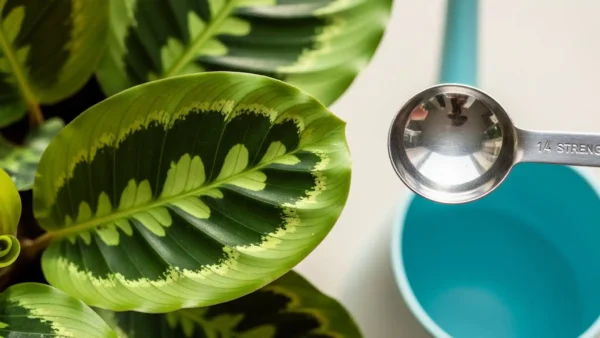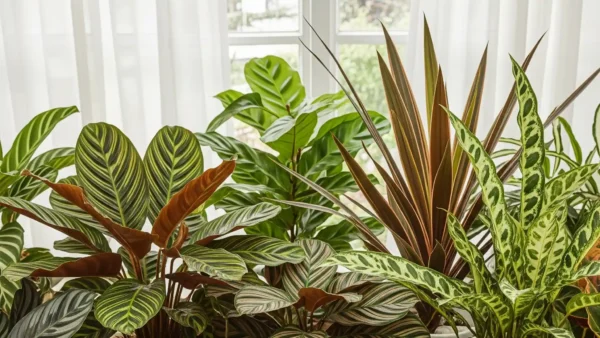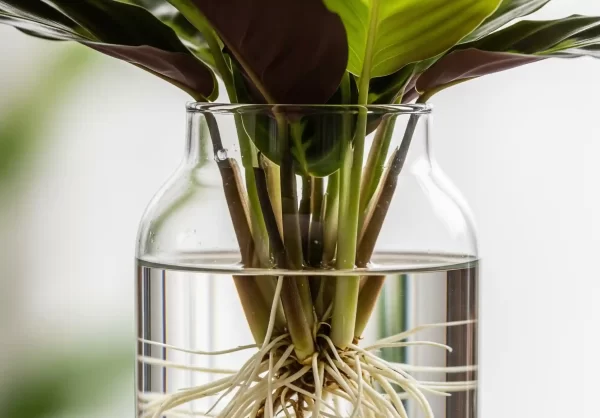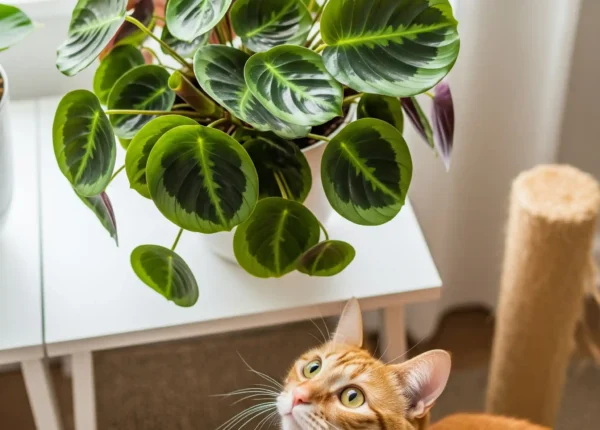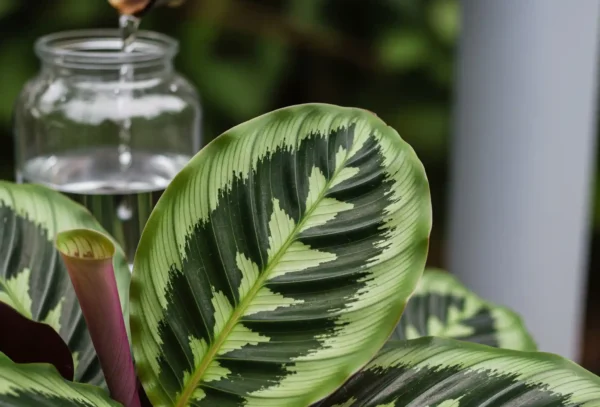How Often to Water Calathea: Master the Art of Hydration for Lush Growth
Oh, Calatheas. These beautiful plants are both a joy and a bit of a riddle, and I’ve discovered this in more than 15 years of gardening. I recall the day my Calathea orbifolia decided to protest. Its gorgeous, wide leaves curled inward and looked like they were going to die. My heart fell. I had done all I believed I was supposed to do, yet something was definitely wrong. People have problems with houseplants mostly because they don’t water them properly. Calatheas, which are quite sensitive, are often the first to reveal it [1].
We’ve all been there before, right? Looking at those crunchy edges or the abrupt yellowing and wondering if we’re drowning them or leaving them dry. It seems like a game of chance. But what if I told you it doesn’t have to be? What if you could learn to listen to your Calathea and comprehend its individual thirst signals? What if you could get rid of strict, one-size-fits-all schedules? It’s not just about how often to water Calathea; it’s about becoming a Calathea Watering Whisperer. You can learn how to hydrate your plants through intuitive observation, a little science, and advanced strategies that will help them grow in a genuinely colorful and luxuriant way. Let’s get started and turn your watering problems into watering successes.
Why Calathea Watering is a Difficult Dance (It’s Not Only About How Often)
We need to know the “why” before we talk about the “how often.” These houseplants aren’t like the ones that are easy to care for. They come from a very distinct place, and that place is incredibly important.
The Rainforest Connection: Copying Native Moisture
Calatheas (Marantaceae family) live in the understory of tropical rainforests in Central or South America. The air is dense with humidity, the light is mottled and indirect, and the forest floor is always wet but never too wet. Imagine a sponge that has been perfectly wrung out. It is always wet but never soggy [3]. Their roots are used to these kinds of conditions, and they do well in soil that drains well but still holds moisture.
Because they are native to this area, Calatheas often get too much water. Their roots like to stay damp all the time, but when the soil is always wet, it cuts off oxygen and kills the roots. It’s a fine line, but we can definitely learn how to walk it.
The Dangers of Watering Inconsistently: Leaves Curl and Edges Get Crispy

To put it mildly, calatheas are creatures of habit. They want everything to stay the same. They react strongly when their watering schedule is all over the place, with one day being bone dry and the next being soaking wet.
- Crispy edges and brown tips are generally the first signs of trouble. They usually mean the plant needs more constant watering, greater humidity, or both. When the soil dries out too much between waterings, the plant has a hard time getting adequate moisture. The leaf edges are the first to show signs of this since they are the farthest from the water supply.
- Curling leaves: This is your Calathea’s way of trying to keep water. It’s a way for the plant to protect itself by lowering the amount of surface area that is exposed to the air. This slows down transpiration. If you see this, your plant is probably very thirsty or going through a lot of stress in its environment.
These signs are clear signs of stress caused by both too much and too little water. The first step to being a watering pro is to know what these signs mean.
How to Figure Out When to Water Your Calathea
Don’t worry about the calendar. Really. Some plants can handle “water once a week,” but Calatheas will not.
Ohio Tropics, a knowledgeable plant blogger and enthusiast, sensibly says, “The short answer is that it DEPENDS! … Don’t listen to your calendar! Instead, check the moisture level in your soil!” [2].
The Finger Test: Your Best Tool

This is the oldest trick in the book, and it works for a reason. Over the years, I’ve found that the best way to do it is to just stick my finger in the dirt.
- How to Do It: Put your finger in the potting mix gently, about one to two inches deep. For smaller pots, one inch is generally enough. For bigger pots, you might need to dig a little deeper, maybe two inches.
- When to Water: It’s time to water well if the soil at that depth feels dry to the touch [1, 2, 3]. Check again in a day or two if it still seems wet. It’s really that easy, but it works quite well.
More than the calendar: things that affect frequency
So, if the calendar doesn’t affect how often your Calathea needs a drink, what does? A lot, really!
Things that affect the environment:
- Temperature: When it’s warmer, the soil evaporates faster and the leaves transpire more, therefore you need to water more often.
- Humidity: When the humidity is lower, the soil will dry up faster, and the plant will lose more water via its leaves, so you will need to water it more often. This takes longer when the humidity is higher.
- Light Levels: Plants that get more indirect light will photosynthesize more and need more water than plants that get less light.
Type and Size of Pot:
- Terra Cotta vs. Plastic: Terra cotta pots have holes in them that let water evaporate through the sides, which makes the soil dry out faster. Pots made of plastic or glazed ceramic hold moisture better.
- Size of the Pot: A smaller pot will dry up much faster than a larger one since it has less soil to hold moisture.
- Soil Mix: A soil mix that drains rapidly and is airy (which Calatheas adore!) will dry out faster than a mix that is dense and heavy. This is a good thing because it stops root rot, but it means you’ll have to water more often.
Moisture Meters: Do They Help?
The finger test is the best way to check for moisture, but moisture meters can be helpful too, especially if you’re just starting out or have a lot of stuff. They tell you how much moisture is in the soil in numbers, which can help you understand what “dry enough” means. Just remember that they measure moisture, not necessarily how thirsty the plant is, and make sure to calibrate them every so often. They are not the truth.
How to Water: Tips for Success
You need to know how to water as well as when to do it. The idea is to soak the root ball all the way through without letting the plant rest in water that isn’t moving.
Calathea’s Favorite Drink: Water from the Bottom
This is my favorite way to care for Calatheas, and I tell everyone to do it this way. It works like roots do in nature to soak up water and stops a lot of problems that happen a lot.
- Make a Basin: Get a bowl, tray, or sink that is big enough to contain the pot of your Calathea.
- Add Water: Fill the basin with 1 to 2 inches of filtered, room-temperature water (we’ll talk more about water quality in a minute).
- Put the plant in the water: Put your potted Calathea right in the water. Make sure the pot has holes at the bottom so the dirt can soak up the water.
- Wait and see: Soak the plant for 20 to 45 minutes, or until the top of the soil feels damp. The line of wetness will progressively move up the container.
- Thoroughly drain: Take the pot out of the basin and let any extra water drain out of the drainage holes after the soil is evenly saturated. Do not allow your Calathea sit in water that is still for long periods of time.
Benefits of Watering from the Bottom:
- Even Saturation: Makes sure that the whole root ball gets wet, which stops dry spots from forming.
- Encourages Deep Roots: Roots grow deeper in quest of water, which makes the root system stronger.
- Keeps Leaves Dry: This lowers the chance of fungal spots and bacterial illnesses that can happen when water sits on leaves.
- Flushes Salts: When done well, it helps get rid of mineral salt accumulation.
Be Careful When Watering
You may water your Calathea from the top, but it needs more care.
- Pour water slowly and evenly over the topsoil until it starts to drain from the pot’s bottom.
- Make sure your pot has drainage holes, and after around 15–30 minutes, dump any extra water from the saucer right away. If you leave the pot in drained water, the roots will decay quickly.
- Don’t Wet the Leaves: If your tap water isn’t very good, try to wet the soil directly so that less water splashes onto the leaves.
The Unsung Hero of Calathea Health: Water Quality
This is something that people often forget about, yet it’s quite crucial for Calatheas. These plants are delicate, and the water you give them can make a big difference.
The Problem with Tap Water: Fluoride, Chlorine, and Mineral Buildup
Chlorine, chloramines, fluoride, and other dissolved mineral salts are common in many municipal tap water sources. Calatheas can be very sensitive to these things, although they are safe for people to eat [10]. As time goes on, these chemicals and salts can build up in the soil, which can make the nutrients in the soil unbalanced and be directly harmful to the plant.
Signs that you are sensitive to tap water: Brown tips or edges on the leaves that don’t seem to be caused by humidity or irregular watering are the most typical symptom [2, 10]. This symptom is annoying, but it usually means that the water isn’t good.
The University of Florida (UF/IFAS) says, “Dead spots near leaf margins. Toxicity of fluoride. Don’t use water or fertilizer that has fluoride in it” [3].
Filtered, distilled, and rainwater are the best options.
I definitely suggest using different water sources for Calatheas that are really pleased.
- Rainwater is like gold if you can gather it! It is naturally soft, doesn’t have chlorine or fluoride, and has good trace minerals in it.
- Distilled water is basically pure H2O, with all minerals and compounds taken out. For plants that are sensitive, it’s a sure bet. Ohio Tropics says, “Many people have had great success using distilled water for their Calatheas and have said that the leaves have very little to no brown edges” [9].
- Filtered Tap Water: A decent water filter, such a Brita or a reverse osmosis system, may get rid of a lot of chlorine, chloramines, and some minerals, which makes tap water taste a lot better for your Calatheas. For many, it’s a reasonable compromise.

If you have to use tap water, here are some tips: If you can’t get filtered or distilled water, you could try letting your tap water soak in an open container for 24 to 48 hours. This lets chlorine off-gas, but not chloramines or fluoride. It’s not the best answer, but it’s better than nothing.
How to Fix Common Watering Problems
Problems can happen even when you try your best. The most important thing is to rapidly figure out if you’re overwatering or underwatering, because the two problems are very different!
Overwatering and underwatering: What’s the difference?
This is the basic problem, and it can be hard to figure out because certain symptoms can look alike. But there are important differences:
Signs of too much water:
- Leaves Turning Yellow: The leaves may start at the bottom and turn yellow. They may feel soft or mushy.
- Soft Stems: The stems or base of the plant may feel soft and squishy, which is a definite indicator of root rot.
- Stunted Growth: The plant stops growing new leaves when it is stunted.
- Bad Smell: The smell of bad soil is a sure symptom of anaerobic conditions and roots that are decomposing.
- Wilting (Paradoxically): Roots that are rotting can’t take in water, which makes plants wilt even when the soil is wet [1].
The answer is to stop watering right away. If the problem is bad, carefully take the plant out, check the roots (cut out any that are dark and mushy), and put it back in new, dry, well-draining soil. Water less often in the future.
Signs of not watering enough:
- Curling Leaves: This is the plant’s way of trying to keep water.
- Crispy Edges: Crispy edges and brown tips, especially if the whole leaf seems dry and brittle.
- Wilting: When the soil is dry, the plant wilts and the earth pulls away from the edges of the pot.
- Slow or No New Growth: The plant is too stressed to grow new leaves.
Water well, ideally from the bottom, to solve the problem. Water a little more often, but always check the soil first.
WVU Extension says it well: “Leaves turning yellow… Too much water… Water less often. Leaves that are brown and crunchy… Not enough water… Water well when the soil is only a little bit dry” [1]. It’s a perpetual dance of watching and changing.
What Soil and Drainage Have to Do with Watering Problems
A lot of watering difficulties aren’t only about how much or how often, but also about the roots’ surroundings.
- Old or compacted soil: Over time, potting mix can break down and become dense, which makes it less able to drain and get air. This makes it hard for water to leave, which can make problems with overwatering worse. It’s time to renew your soil if it looks like muck.
- The Importance of Drainage Holes: I can’t say this enough. If your pot doesn’t have holes for water to drain out of, it will sit in still water, which will cause root rot. Always utilize pots that have holes in the bottom. If you love a gorgeous pot that doesn’t have any holes, use it as a cachepot and put your Calathea in a nursery pot with drainage inside.
In conclusion, your journey to confidently water your Calathea
It’s not a secret formula that will help you figure out how often to water Calathea. Instead, you need to learn how to really see what these amazing plants require and how to touch them gently. It’s about going from guessing to having an informed gut feeling, and from being angry to thriving. Keep in mind that every curled leaf or crunchy tip is just your Calathea telling you what it needs. If you keep an eye on your plant, learn what makes it thirsty, and give it the correct kind of water, you’ll be able to keep its leaves healthy and colorful.
So, go ahead and put your finger in the dirt, look at those pretty leaves, and trust your gut. Your Calathea will be grateful for it, and your home will become a tiny piece of rainforest heaven.
What is the biggest success or recurring problem you’ve had with watering your Calathea? Share your tale below! We’d love to hear it, and your story might help another plant parent who is having a hard time.
Sources and Further Reading
- WVU Extension – West Virginia University. (n.d.). A Guide to Conquering the Houseplant Jungle. https://extension.wvu.edu/files/d/d82924be-5fb5-480d-af6d-b1d0a23c1806/wlg-177-houseplants-digital.pdf
- Ohio Tropics. (2022). The BEST Distilled Water Alternative for Watering Calathea. Ohio Tropics Plant Blog. https://www.ohiotropics.com/2022/10/07/distilled-alternative-calathea/
- University of Florida (UF/IFAS) Central Florida Research and Education Center. (n.d.). Calathea Production Guide. https://mrec.ifas.ufl.edu/foliage/folnotes/calathea.htm
- Chen, C. et al. (2018). Biochemical and Physiological Characteristics of Photosynthesis in Calathea. Journal of Plant Biology. https://pmc.ncbi.nlm.nih.gov/articles/PMC5877565/
- Genk, D. (2024). The impact of plants on the humidity of naturally-ventilated indoor environments. Frontiers in Plant Science. https://www.sciencedirect.com/science/article/pii/S2352710224003826
- ISHS. (2017). Photosynthesis and chlorophyll fluorescence of Calathea ‘Medallion’ exposed to different light intensity. Acta Horticulturae (ISHS). https://www.ishs.org/ishs-article/1167_49
- Vanessa Madu. (2024). Calathea Research Log #1: The Office Calathea. Plant Hospital—Vanessa Madu. https://www.vanessamadu.com/posts/plant-hospital-1/
- Plants For All Seasons. (2022). A Guide to Calathea Soil. Plants For All Seasons Blog. https://www.plantsforallseasons.co.uk/blogs/calathea-care/a-guide-to-calathea-soil
- Cafe Planta. (2025). The Best Calathea Fertilizer: A Comprehensive Guide. Cafe Planta Blog. https://cafeplanta.com/a/blog/the-best-calathea-fertilizer-a-comprehensive-guide
- Fluoride Alert Network. (2024). Three popular houseplants that “hate” tap water as it can be detrimental to their health. FluorideAlert.org News. https://fluoridealert.org/news/three-popular-houseplants-that-hate-tap-water-as-it-can-be-detrimental-to-their-health/
- Patch Plants. (2025). Complete guide to calathea care. Patch Plants Plant Care Guides. https://www.patchplants.com/pages/plant-care/complete-guide-to-calathea-care/
- Urban Thumbs. (2023). Creating the Perfect Soil Mix for Calathea. Urban Thumbs Blog. https://urbanthumbs.com.au/index.php?route=extension%2Fsimple_blog%2Farticle%2Fview&simple_blog_article_id=31
- PMC. (2014). Comparative phylogeography of eight herbs and lianas (Marantaceae, understorey plants). PubMed Central. https://pmc.ncbi.nlm.nih.gov/articles/PMC4237126/


